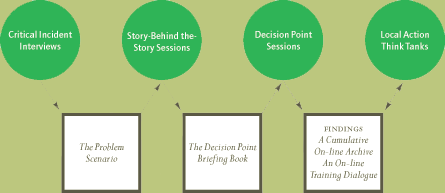Welcome to Teachers & Students!
Holding a Community Think Tank can be an outreach, writing, and service learning project that makes a real contribution to your community. It allows students to develop both critical literacy and an inquiry-based awareness of local social problems (to which they might otherwise have limited access). Students learn how to work in diverse cultural groups as problem-solvers responding to complex social problems.Why initiate a Think Tank?
Why would teachers and students initiate a Community Think Tank inquiry?
Developing a think tank as a course project lets students participate in:
- A structured inquiry into a pressing community problem. See the steps in the process:

...and the roles of community/university partners.
- A dynamic, strongly motivated, intercultural and interpersonal dialogue that draws out the important knowledge of the urban community--knowledge that is usually silenced.
- A collaborative process of argument and case building that uses diversity to build new knowledge.
- A hands-on experience using skills in research, listening, problem analysis, and presentation to document new knowledge.
- An opportunity to make a genuine contribution to a professional and public forum in which the rhetoric of inquiry can make a difference.
What makes the Think Tank unique?
The Think Tank creates a socially, culturally, and economically diverse community of problem-solvers involving people who are not usually included in high-level, complex problem-solving. Its process of structured inquiry respects knowledge from many levels of experience—low-wage workers, management, community workers, ministers, youth, academics, policy experts, and students (among others). While many community forums adopt a rhetoric of complaint and blame, Think Tanks seek both strong rival hypotheses and diverse interpretations of problems in order to explore options and test solutions. Think Tanks situate problems and solutions in their local contexts—in a workplace, a city, an economic trend, or an ideology.
See how the Rivaling strategy works.
See how the Option and Outcome strategy is used.
What do students say they learn?
To address this question, we looked at reflections from a class on the rhetoric of making a difference, in which students were considering rivals and answering the question: can the process of inquiry actually make a difference?
What is the nature of the university and community partnership?
What is the nature of the university and community partnership?
The community and university are working partners throughout the think tank process. Community and university members work together to identify, analyze, and solve problems. Carnegie Mellon's Think Tank team supports this process by facilitating the inquiry and documenting the results.
See the steps in the process:

See the roles of community/university partners.
See a bibliography addressing community/university partnerships
How can writing and rhetoric address community problems?
The muscle behind the Think Tank process comes from four powerful rhetorical strategies: Collaborative Planning, Finding the Story Behind the Story, Gaining Rival Interpretations, and Seeking Options and Outcomes. These strategies for inquiry and dialogue focus on an equitable sharing of knowledge, the construction of sensitive and situated problem analysis, and the exploration and implementation of viable problem solutions. Learn more about the rhetorical strategies of the Think Tank by following the above links. Or, see an example of the strategies in action.
How can this process work in the classroom?
How can a Community Problem-Solving Dialogue work in the classroom?
The syllabus for the Leadership, Dialogue and Change course
The syllabus for Literacy: Educational Theory and Community Practice
The Community Literacy Bibliography